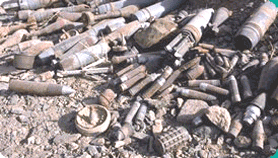After witnessing the widespread harm inflicted upon civilian populations by specific weapons during the Second World War, it became clear to the international community that there was a need to address particularly harmful and indiscriminate weapons through bans and restrictions on their use. The devastating humanitarian impact of the wars in Indochina throughout the 1960s and 1970s reinforced this view and led to the establishment of a new Convention designed to restrict or prohibit the use of certain weapons through individual Protocols that could be added to the Convention as State Parties saw fit.
Adopted in 1980, the CCW is a major instrument of international humanitarian law which seeks to minimize the humanitarian impact of certain weapons that have indiscriminate effects or that inflict human costs disproportionate to their military utility. Ratified by 94 countries, the Convention includes protocols that prohibit or place conditions on the use of weapons employing fragments that are undetectable by x-rays, blinding laser weapons, landmines, booby traps, and incendiary weapons. After the failure of the CCW to formulate an adequate response to the global landmine crisis and with overwhelming international support for stronger action against landmines, anti-personnel mines were comprehensively banned by the 1997 Ottawa Convention.
At the CCW's Second Review Conference in 2001, several non-governmental organizations, including the founding members of the CMC, urged States Parties to the CCW to adopt appropriate measures to address the problems caused by explosive remnants of war (ERW). It was agreed to establish two Groups of Governmental Experts to explore the issues of ERW and anti-vehicle mines, also referred to as Mines Other than Anti-Personnel Mines (MOTAPM).
Negotiations in 2003 created a new instrument on ERW - Protocol V of the CCW - that addresses responsibility for clearance of ERW, information sharing for clearance and risk education, provision of warnings to civilian populations, and international cooperation and assistance. A small number of NGOs were actively engaged in this process including several founding members of the CMC. The new Protocol was adopted in November 2003 and will enter into force after 20 countries ratify the Protocol. Although NGOs and many States Parties would have preferred a stronger instrument, the CMC views Protocol V as a useful first step in addressing the ERW problem.
Having taken steps to address the existing problem of ERW, the challenge now before the CCW and international community in general is to prevent a new crisis on the scale of the global landmine crisis from emerging as a result of the use of cluster munitions.
Although they are clearly the weapons in most need of international regulation, there are currently no provisions in international humanitarian law that specifically address the humanitarian impact of submunitions. The new legally binding Protocol on ERW, adopted at the CCW in November 2003, is a positive step towards reducing the number of civilian casualties and facilitating the resumption of normal life in post-conflict settings. This Protocol will enter into force once 20 States Parties have ratified it.
However, beyond this Protocol, new international law is urgently required on preventative measures. These measures must include restrictions on the targeting and use of cluster munitions, as well as strict technical standards to improve the reliability of cluster munitions and other specific weapon systems that have demonstrated a clear tendency to produce ERW. The CMC is a strong advocate for creating new measures, both nationally and internationally, to eliminate the humanitarian problems created by all explosive remnants of war. The CMC will continue its work to have the CCW include new protocols and preventative measures and on specific weapons. The CMC also calls for a moratorium on the use, production or trade of cluster munitions by all States until the humanitarian problems created by those weapons are adequately addressed. While States Parties to the CCW are engaging on deliberations to deal with the humanitarian impact of this weapon, it is only logical for those States to stop using cluster munitions until these diplomatic efforts have concluded.



















